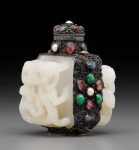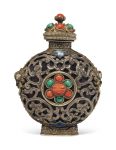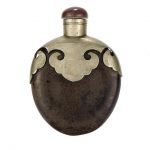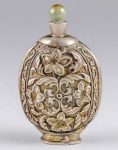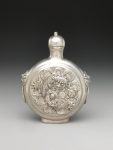Snuff Bottles. Tobacco was introduced by the Portuguese to the court at Beijing some time during the mid- to late-16th century. It was originally smoked in pipes before the establishment of the Qing Dynasty. The use of snuff and snuff bottles spread through the upper class, and by the end of the 17th century it had become a part of social ritual to use snuff. This lasted through most of the 18th century. Eventually, the trend spread into the rest of the country and into every social class. It was common to offer a pinch of snuff as a way to greet friends and relatives. Snuff bottles soon became an object of beauty and a way to represent status and wealth.
The use of snuff increased and decreased with the rise and fall of the Qing Dynasty and died away soon after the establishment of the Republic of China. However, contemporary snuff bottles are still being made, and can be purchased in souvenir shops, flea markets and museum gift shops. Original snuff bottles from the Qing period are a desirable target for serious collectors and museums. A good bottle has an extra quality over and above its exquisite beauty and value: that is touch. Snuff bottles were made to be held and so, as a rule, they have a pleasant tactile quality. Reference: Wikipedia
A silver snuff bottle inset with white jade belt buckle sections Bottle: Republic period; jade: 18th century Supported on an oval foot ring, the silver body decorated with filigree scrolls in addition to inlaid jade, ruby, rose quartz, and other semi-precious cabochons, each main side inset with a section from a jade belt buckle deeply undercut with a chilong holding a lingzhi sprig in its mouth. 2 1/2in (6.4cm) high
Sold for US$ 2,125 (£ 1,604) inc. premium at Bonhams in 2018
A RARE PARCEL-GILT INLAID SILVER AND GLASS SNUFF BOTTLE PROBABLY PALACE WORKSHOPS, BEIJING, 1760-1820 The bottle consists of a dark amber glass inner bottle encased in an outer silver shell decorated on either side in openwork with scrolling dragons surrounding a central flower-head medallion inset with malachite and coral-colored glass petals encircling a shou character, while the narrow sides have gilt-silver lion-mask and ring handles on vertical foliate straps, all between borders of blue champlevé enamel ruyi heads above the gilt-silver foot and below the gilt-silver neck. The gilt-silver cover is similarly inlaid. 2 3/8 in. (6 cm.) high, matching metal inlaid stopper and metal spoon
Sold for USD 9,375 at Christies in 2018
Chinese Silver Mounted Seed Pod Snuff Bottle 18th/19th Century Of organic form, the neck and shoulders with a ruyi collar shaped mount. Height 2 1/4 inches.
Sold for $1,187 (includes buyer’s premium) at Doyle New York in 2018
Antique Chinese jade and silver snuff bottle. Decorated with reliefs of flowers. Height: 8.5 cm.
Sold for $800 at Ishtar Antiques LTD. in 2019
Snuff Bottle with Lions Period: Qing dynasty (1644–1911) Date: 19th century
Reference: The Metropolitan Museum of Art
A SILVER ‘SCHOLARS IN A GARDEN’ SNUFF BOTTLE LATE QING DYNASTY together with a watercolour illustration by Peter Suart 8.5 cm., 3 3/8 in.
Although unmarked, which is unusual for southern Chinese silver ware, this fits comfortably into the range of export wares made mostly in the south during the late Qing dynasty (see under Sale 5, lot 48). Like Sale 5, lot 48, it has been initially beaten from the reverse side and subsequently chased. There is very obviously only one join, however, so a sheet of silver must have been bent around to form the main body, which implies that the sheet of metal had its main design formed first and was then wrapped around on itself and joined vertically. The neck, base, and foot rim were added afterwards. This has had considerable wear, suggesting that it might have remained in use in China rather than being exported to cabinet life in the West. It is possible that an export silver maker diverted this bottle for his own use (thus feeling no need to add his self-proclaiming shop mark to it). The wear could also be explained by a foreign snuff taker choosing to use the snuff bottle rather than a box, perhaps as an exotic fashion statement to impress his friends at home.
Sold for 31,250 HKD at Sothebys in 2014
